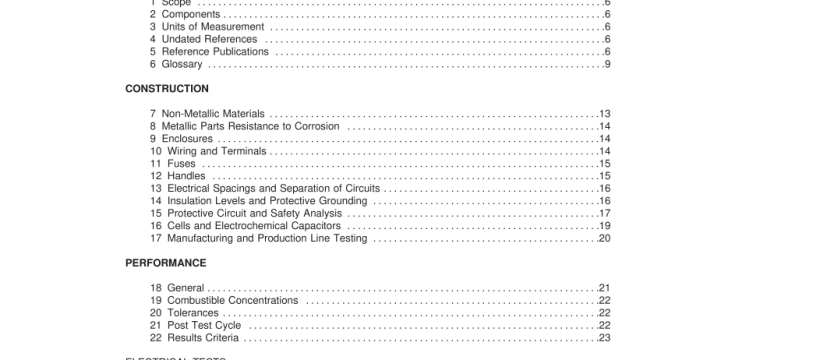UL 2271-2010 pdf download.Batteries for Use In Light Electric Vehicle (LEV) Applications.
6.7 CHARGING, CONSTANT CURRENT (CC) – Charging mode where current is held constant while charging voltage is allowed to vary. 6.8 CHARGING, CONSTANT VOLTAGE (CV) – Charging mode where voltage is held constant while charging current is allowed to vary. 6.9 DUT – Device under test. 6.1 0 ELECTRIC ENERGY STORAGE ASSEMBLY (EESA) – A battery pack, electrochemical capacitor pack or combination battery/electrochemical capacitor pack that provides electric energy for electric vehicle motive power. This assembly can include the cooling and ventilation systems and battery management systems. 6.1 1 ELECTRIC SHOCK HAZARD – A potential for exposure of persons to hazardous voltages circuits through direct contact from openings in protective enclosures and/or insufficient insulation between hazardous voltage circuits and accessible parts. 6.1 2 ELECTROCHEMICAL CAPACITOR – An electric energy storage device where electrical charge is typically stored as a result of non-Faradaic reactions at the electrodes. (A subset of electrochemical capacitors referred to as an ″asymmetric″ type have non-Faradaic reactions at one electrode and Faradaic reactions at the other electrode.) The porous surface of the electrodes increases the surface area for holding charge resulting in much larger capacitance and energy density. Electrochemical capacitors differ from common electrolytic capacitors in that they employ a liquid rather than a solid dielectric with charge occurring at the liquid-solid interface of the electrodes when a potential is applied. Some other common names for an electrochemical capacitor are ″double layer capacitor″, ″ultracapacitor″, ″electrochemical double layer capacitor″ and ″super capacitor″.
6.1 3 ELECTROLYTE LEAKAGE – A condition where liquid electrolyte escapes through an opening in a designed vent as well as through a rupture or crack or other unintended opening in the casing or enclosure of a cell or capacitor and is visible external to the DUT. 6.1 4 ENCLOSURE – The outer cover of the EESA that provides protection to its contents. 6.1 5 END-OF-DISCHARGE VOLTAGE (EODV) – The voltage, under load, of the cell or battery at the end of discharge. The EODV may be specified, as in the case of a voltage terminated discharge, or simply measured in the case of a time-controlled discharge. 6.1 6 EXPLOSION – A violent release of energy that produces projectiles or an energy wave from the DUT and results in the DUT’s contents being forcibly expelled through a rupture in the enclosure or casing. 6.1 7 FIRE – The sustained combustion of the DUT’s contents as evidenced by flame, heat and charring or other damage of materials. 6.1 8 FULLY CHARGED – An EESA which has been charged per the manufacturer’s specifications to it full state of charge (SOC). 6.1 9 FULLY DISCHARGED – An EESA, which has been discharged, according to the manufacturer’s specifications, to its specified end of discharge voltage (EODV).
6.20 HAZARDOUS VOLTAGE – Voltage exceeding 30 Vrms/42.4 Vac peak or 60 Vdc. 6.21 INSULATION LEVELS – The following are levels of electrical insulation: a) BASIC – A single level of insulation that provides protection against electric shock. Basic insulation alone may not provide protection from electric shock in the event of a failure of the insulation. b) DOUBLE INSULATION – Insulation comprising both basic insulation and supplementary insulation. c) FUNCTIONAL INSULATION – Insulation that is necessary only for the correct functioning of the equipment. Functional insulation by definition does not protect against electric shock. It may, however, reduce the likelihood of ignition and fire. d) REINFORCED INSULATION – Single insulation system that provides a degree of protection against electric shock equivalent to double insulation under the conditions specified in this standard. The term ″insulation system″ does not imply that the insulation has to be in one homogeneous piece. It may comprise several layers that cannot be tested as basic insulation and supplementary insulation. e) SUPPLEMENTARY INSULATION – Independent insulation applied in addition to basic insulation in order to reduce the risk of electric shock in the event of a failure of the basic insulation.UL 2271-2010 pdf download.
UL 2271-2010 pdf download
